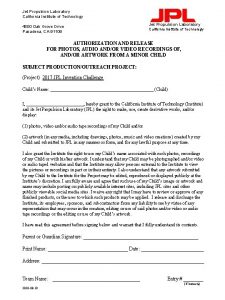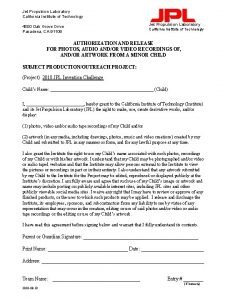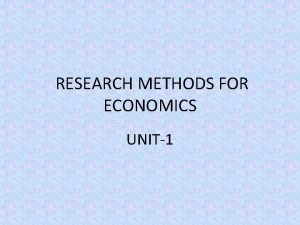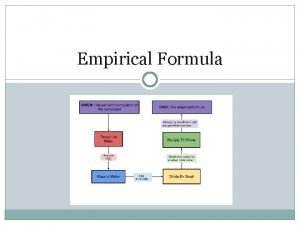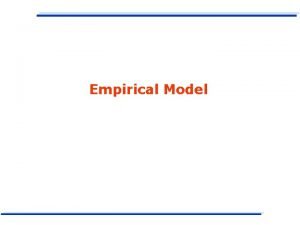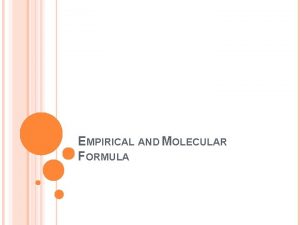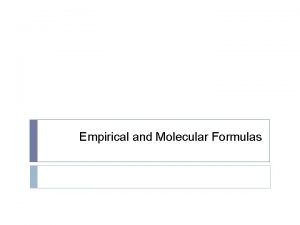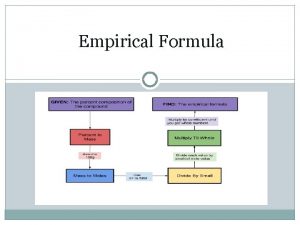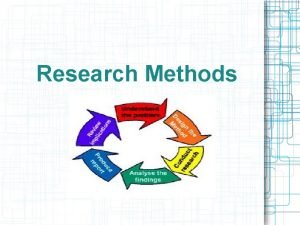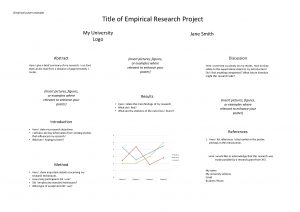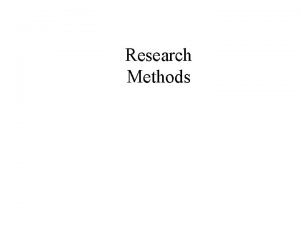IS 4800 Empirical Research Methods for Information Science











































- Slides: 43

IS 4800 Empirical Research Methods for Information Science Class Notes March 16, 2012 Instructor: Prof. Carole Hafner, 446 WVH hafner@ccs. neu. edu Tel: 617 -373 -5116 Course Web site: www. ccs. neu. edu/course/is 4800 sp 12/

Outline • • • Sampling and statistics (cont. ) T test for paired samples T test for independent means Analysis of Variance Two way analysis of Variance

Relationship Between Population and Samples When a Treatment Had No Effect 3

Relationship Between Population and Samples When a Treatment Had An Effect 4

Sampling Mean? Variance? Population m Sample of size N Mean values from all possible samples of size N aka “distribution of means” MM = m ZM = ( M - m ) /

Z tests and t-tests t is like Z: Z=M-μ/ t=M–μ/ μ = 0 for paired samples We use a stricter criterion (t) instead of Z because is based on an estimate of the population variance while is based on a known population variance. S 2 = Σ (X - M)2 = N– 1 SS N-1 S 2 M = S 2/N

T-test with paired samples Given info about population of change scores and the sample size we will be using (N) We can compute the distribution of means ? m=0 S 2 est s 2 from sample = SS/df Now, given a particular sample of change scores of size N and finally determine the probability that this mean occurred by chance S 2 M = S 2/N We compute its mean df = N-1

t test for independent samples Given two samples Estimate population variances (assume same) Estimate variances of distributions of means Estimate variance of differences between means (mean = 0) This is now your comparison distribution

Estimating the Population Variance S 2 is an estimate of σ2 S 2 = SS/(N-1) for one sample (take sq root for S) For two independent samples – “pooled estimate”: S 2 = df 1/df. Total * S 12 + df 2/df. Total * S 22 df. Total = df 1 + df 2 = (N 1 -1) + (N 2 – 1) From this calculate variance of sample means: S 2 M = S 2/N needed to compute t statistic S 2 difference = S 2 Pooled / N 1 + S 2 Pooled / N 2

t test for independent samples, continued Distribution of differences between means This is your comparison distribution NOT normal, is a ‘t’ distribution Shape changes depending on df df = (N 1 – 1) + (N 2 – 1) Compute t = (M 1 -M 2)/SDifference Determine if beyond cutoff score for test parameters (df, sig, tails) from lookup table.

ANOVA: When to use • Categorial IV numerical DV (same as t-test) • HOWEVER: – There are more than 2 levels of IV so: – (M 1 – M 2) / Sm won’t work

ANOVA Assumptions • Populations are normal • Populations have equal variances • More or less. . 12

Basic Logic of ANOVA • Null hypothesis – Means of all groups are equal. • Test: do the means differ more than expected give the null hypothesis? • Terminology – Group = Condition = Cell 13

Accompanying Statistics • Experimental – Between-subjects • Single factor, N-level (for N>2) – One-way Analysis of Variance (ANOVA) • Two factor, two-level (or more!) – Factorial Analysis of Variance – AKA N-way Analysis of Variance (for N IVs) – AKA N-factor ANOVA – Within-subjects • Repeated-measures ANOVA (not discussed) – AKA within-subjects ANOVA 14

ANOVA: Single factor, N-level (for N>2) • The Analysis of Variance is used when you have more than two groups in an experiment – The F-ratio is the statistic computed in an Analysis of Variance and is compared to critical values of F – The analysis of variance may be used with unequal sample size (weighted or unweighted means analysis) – When there are just 2 groups, ANOVA is equivalent to the t test for independent means 15

One-Way ANOVA – Assuming Null Hypothesis is True… Within-Group Estimate Of Population Variance Between-Group Estimate Of Population Variance M 1 M 2 M 3

Justification for F statistic

Calculating F

Example

Example

Using the F Statistic • Use a table for F(BDF, WDF) – And also α BDF = between-groups degrees of freedom = number of groups -1 WDF = within-groups degrees of freedom = Σ df for all groups = N – number of groups

One-way ANOVA in SPSS

Data Mean 23

Analyze/Compare Means/One Way ANOVA… 24

SPSS Results… F(2, 21)=9. 442, p<. 05

Factorial Designs • Two or more nominal independent variables, each with two or more levels, and a numeric dependent variable. • Factorial ANOVA teases apart the contribution of each variable separately. • For N IVs, aka “N-way” ANOVA 26

Factorial Designs • Adding a second independent variable to a singlefactor design results in a FACTORIAL DESIGN • Two components can be assessed – The MAIN EFFECT of each independent variable • The separate effect of each independent variable • Analogous to separate experiments involving those variables – The INTERACTION between independent variables • When the effect of one independent variable changes over levels of a second • Or– when the effect of one variable depends on the level of the other variable. 27

Example Wait Time Sign in Student Center vs. No Sign Satisfaction

Example of An Interaction - Student Center Sign – 2 Genders x 2 Sign Conditions F M No Sign

Two-way ANOVA in SPSS 30

Analyze/General Linear Model/Univariate 31

Results 32

Results 33

Degrees of Freedom • df for between-group variance estimates for main effects – Number of levels – 1 • df for between-group variance estimates for interaction effect – Total num cells – df for both main effects – 1 – e. g. 2 x 2 => 4 – (1+1) – 1 = 1 • df for within-group variance estimate – Sum of df for each cell = N – num cells • Report: “F(bet-group, within-group)=F, Sig. ” 34

Publication format N=24, 2 x 3=6 cells => df Training. Days=2, df within-group variance=24 -6=18 => F(2, 18)=7. 20, p<. 05

Reporting rule • IF you have a significant interaction • THEN – If 2 x 2 study: do not report main effects, even if significant – Else: must look at patterns of means in cells to determine whether to report main effects or not. 36

Results? Sig. 0. 34 0. 12 0. 41 Training. Days Trainer Training. Days * Trainer n. s.

Results? Training. Days Trainer Training. Days * Trainer Sig. 0. 34 0. 12 0. 02 Significant interaction between Training. Days And Trainer, F(2, 22)=. 584, p<. 05

Results? Training. Days Trainer Training. Days * Trainer Sig. 0. 34 0. 02 0. 41 Main effect of Trainer, F(1, 22)=. 001, p<. 05

Results? Training. Days Trainer Training. Days * Trainer Sig. 0. 04 0. 12 0. 01 Significant interaction between Training. Days And Trainer, F(2, 22)=. 584, p<. 05 Do not report Training. Days as significant

Results? Training. Days Trainer Training. Days * Trainer Sig. 0. 04 0. 02 0. 41 Main effects for both Training. Days, F(2, 22)=7. 20, p<. 05, and Trainer, F(1, 22)=. 001, p<. 05

“Factorial Design” • Not all cells in your design need to be tested – But if they are, it is a “full factorial design”, and you do a “full factorial ANOVA” Real-Time Retrospective Agent Ö Ö Text Ö X

Higher-Order Factorial Designs • More than two independent variables are included in a higher-order factorial design – As factors are added, the complexity of the experimental design increases • The number of possible main effects and interactions increases • The number of subjects required increases • The volume of materials and amount of time needed to complete the experiment increases 43
 4800 oak grove drive pasadena
4800 oak grove drive pasadena 4800 oak grove drive
4800 oak grove drive 4800 bc popcorn
4800 bc popcorn Intercomunicacion
Intercomunicacion Checkpoint 4200
Checkpoint 4200 Mazak fh 4800
Mazak fh 4800 Qualitative research methods in political science
Qualitative research methods in political science Research methods in exercise science
Research methods in exercise science What is my favourite subject
What is my favourite subject Wax pattern fabrication
Wax pattern fabrication Types of research empirical vs
Types of research empirical vs Conceptual vs empirical
Conceptual vs empirical Empirical research meaning
Empirical research meaning Formuö
Formuö Typiska drag för en novell
Typiska drag för en novell Tack för att ni lyssnade bild
Tack för att ni lyssnade bild Ekologiskt fotavtryck
Ekologiskt fotavtryck Shingelfrisyren
Shingelfrisyren En lathund för arbete med kontinuitetshantering
En lathund för arbete med kontinuitetshantering Särskild löneskatt för pensionskostnader
Särskild löneskatt för pensionskostnader Tidböcker
Tidböcker Sura för anatom
Sura för anatom Vad är densitet
Vad är densitet Datorkunskap för nybörjare
Datorkunskap för nybörjare Tack för att ni lyssnade bild
Tack för att ni lyssnade bild Debattartikel mall
Debattartikel mall Delegerande ledarstil
Delegerande ledarstil Nyckelkompetenser för livslångt lärande
Nyckelkompetenser för livslångt lärande Påbyggnader för flakfordon
Påbyggnader för flakfordon Formel för lufttryck
Formel för lufttryck Publik sektor
Publik sektor Kyssande vind analys
Kyssande vind analys Presentera för publik crossboss
Presentera för publik crossboss Teckenspråk minoritetsspråk argument
Teckenspråk minoritetsspråk argument Kanaans land
Kanaans land Klassificeringsstruktur för kommunala verksamheter
Klassificeringsstruktur för kommunala verksamheter Luftstrupen för medicinare
Luftstrupen för medicinare Bästa kameran för astrofoto
Bästa kameran för astrofoto Centrum för kunskap och säkerhet
Centrum för kunskap och säkerhet Programskede byggprocessen
Programskede byggprocessen Bra mat för unga idrottare
Bra mat för unga idrottare Verktyg för automatisering av utbetalningar
Verktyg för automatisering av utbetalningar Rutin för avvikelsehantering
Rutin för avvikelsehantering Smärtskolan kunskap för livet
Smärtskolan kunskap för livet
